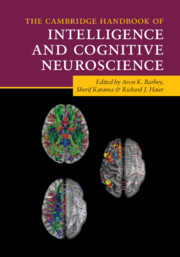Book contents
- The Cambridge Handbook of Intelligence and Cognitive Neuroscience
- Reviews
- The Cambridge Handbook of Intelligence and Cognitive Neuroscience
- Copyright page
- Dedication
- Contents
- Figures
- Tables
- Contributors
- Preface
- Part I Fundamental Issues
- Part II Theories, Models, and Hypotheses
- Part III Neuroimaging Methods and Findings
- Part IV Predictive Modeling Approaches
- Part V Translating Research on the Neuroscience of Intelligence into Action
- 18 Enhancing Cognition
- 19 Patient-Based Approaches to Understanding Intelligence and Problem-Solving
- 20 Implications of Biological Research on Intelligence for Education and Public Policy
- 21 Vertical and Horizontal Levels of Analysis in the Study of Human Intelligence
- 22 How Intelligence Research Can Inform Education and Public Policy
- 23 The Neural Representation of Concrete and Abstract Concepts
- Index
- References
20 - Implications of Biological Research on Intelligence for Education and Public Policy
from Part V - Translating Research on the Neuroscience of Intelligence into Action
Published online by Cambridge University Press: 11 June 2021
- The Cambridge Handbook of Intelligence and Cognitive Neuroscience
- Reviews
- The Cambridge Handbook of Intelligence and Cognitive Neuroscience
- Copyright page
- Dedication
- Contents
- Figures
- Tables
- Contributors
- Preface
- Part I Fundamental Issues
- Part II Theories, Models, and Hypotheses
- Part III Neuroimaging Methods and Findings
- Part IV Predictive Modeling Approaches
- Part V Translating Research on the Neuroscience of Intelligence into Action
- 18 Enhancing Cognition
- 19 Patient-Based Approaches to Understanding Intelligence and Problem-Solving
- 20 Implications of Biological Research on Intelligence for Education and Public Policy
- 21 Vertical and Horizontal Levels of Analysis in the Study of Human Intelligence
- 22 How Intelligence Research Can Inform Education and Public Policy
- 23 The Neural Representation of Concrete and Abstract Concepts
- Index
- References
Summary
In his 2011 book, Incognito, Stanford neuroscientist David Eagleman asked us to:
Imagine for a moment that we are nothing but the product of billions of years of molecules coming together and ratcheting up through natural selection, that we are composed only of highways of fluids and chemicals sliding along roadways within billions of dancing cells, that trillions of synaptic conversations hum in parallel, that this vast egglike fabric of micron-thin circuitry runs algorithms undreamt of in modern science, and that these neural programs give rise to our decision making, loves, desires, fears, and aspirations.
(Eagleman, 2011, p. 223)To me, that understanding would be a numinous experience, better than anything ever proposed in anyone’s holy text.
(p. 224)- Type
- Chapter
- Information
- Publisher: Cambridge University PressPrint publication year: 2021

